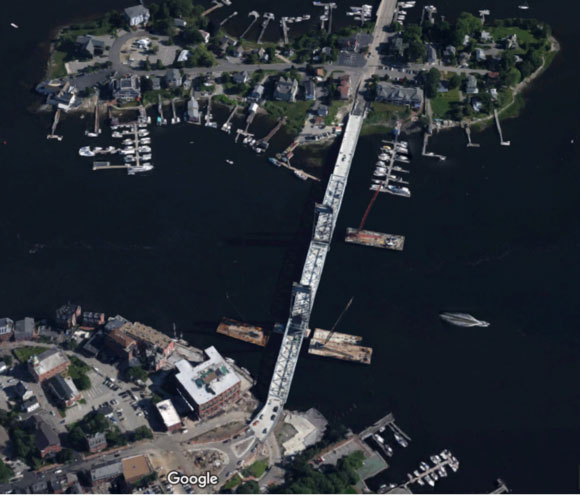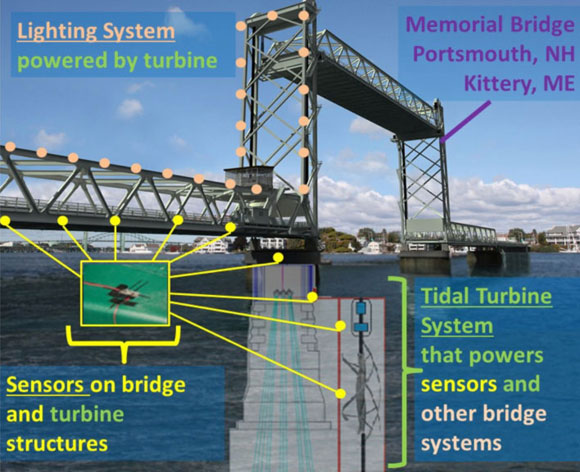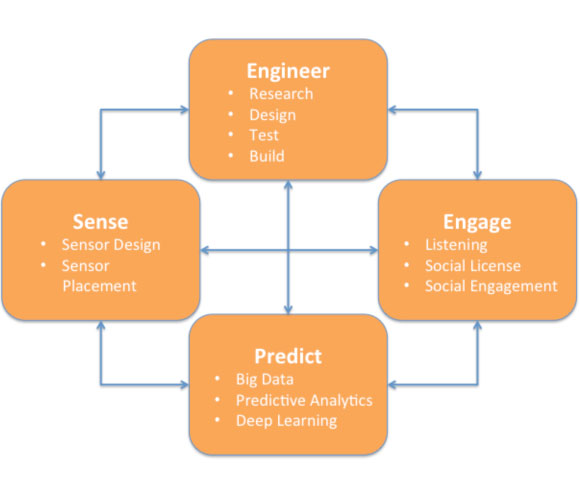New Skills to Build The Living Bridge: a Conversation with Dr. Erin Bell
“The future is here, it is just not evenly distributed.”
William Gibson
Governments are preparing a massive renewal of infrastructure. In Canada, the government plans to stimulate the economy with a $125 billion infrastructure fund. In the United States, this number is proportionally larger with a number as high as $1 trillion frequently mentioned. But tomorrow’s infrastructure is not the same as yesterdays. How do engineering companies prepare? Look for the places where the future is already here.
What do you do with an old bridge? The Memorial Bridge linking Portsmouth New Hampshire and Kittery Maine was opened in 1923 and was in service until 2011. It was closed suddenly in December 2010 because of emergency safety concerns, demolished as the bid for repairs came in $15 million over budget. A new bridge was built opening in 2013; and what a bridge it turned out to be.

The new Memorial Bridge is not so much a marvel of design by a star architect like Renzo Piano or Santiago Calatrava. Instead, what makes this bridge important is its intelligence and the community that has grown up around it. Ted Zoli of HNTB Corp., a Macarthur Fellow and one of America’s leading bridge engineers led the design work. Partnered with him was Dr. Erin Bell of the University of New Hampshire. Why have a research partner on a bridge replacement project?
The Memorial Bridge is an iconic bridge for the area, and it has become a juncture for a lot of innovation, engineering, scientific and social. The ‘Living Bridge’ is well fitted with sensors. There are strain transducers and accelerometers; tiltmeters and strain rosettes (to measure two-dimensional strain on the truss members). The bridge also has its own miniature weather station to collect data on the immediate environment and cameras to observe the bridge deck, the tidal generator, and the river. Yes, you read that right. Living organisms need energy so this bridge, a living bridge, comes with its own source of power, a tidal generator. In fact, it was the request that the bridge be used as a platform for a tidal generator that drove many of the other innovations, as the stress of carrying the generator on the bridge structure needed to be monitored.

So far, this sounds like a pretty standard modern bridge, with a bit more kick and its own tidal power. The Living Bridge project has grown into something much wider than this. The motto for the project is “Connecting Generations and Bridging Communities” and that is just what this project has done. A lot of research is carried out around this bridge, which has open sourced its data to both scientific researchers and educational communities. In addition to Dr. Bell, the advisory board includes Dr. Tat Fu, who is focussed on the structural performance, Dr. Kenneth Baldwin and Dr. Martin Wosnik, experts in mechanical and ocean engineering, and Dr. Lawrence Hamilton, who leads the social and community engagement aspect of the work. Of course, each of these people brings in their students to work on specific projects. On the government side, the Department on Transport, the Department of Energy and various educational institutions are also engaged.
Dr. Bell herself has an interesting background. Her grandfather was a blacksmith and her father a steel fabricator. She put herself through university by working as a steel fabricator herself which gives her a deep understanding not only of the material but the people who work with it. She is now an expert on steel and the performance of steel structures. Today, that means she is also an expert in using sensors to monitor structural performance. But this project went way beyond the normal demands of a structural engineering project. The many different research directions and communities meant that Dr. Bell had to grow whole new skillsets.
The most important of these is community building and facilitation. The social skill that underlies this is listening. Listening is one of the most important skills for people leading multidisciplinary projects. (It is also the skill that describes top consultants). Of course, Dr. Bell had to develop many other related skills: Community Engagement, Stakeholder Management, Stakeholder Communication, Consensus Building, Social Media and on and on. These are now important skills for people leading projects that involve community engagement and social license. These seem to be most public infrastructure projects these days.

The Living Bridge is a good case study of the skills consulting engineering companies are going to need for the coming wave of infrastructure investment. There are the basic design and engineering skills, which are constantly advancing, but these are no longer enough for a successful project. Infrastructure is becoming part of the Internet of Things, the world of connected devices. All of the Internet of Things skills are now needed for infrastructure projects from bridges and highways to water management systems and transit. All of the data collected by these sensors is used to better design and manage the infrastructure and to make predictions about performance and interactions. All of this requires the ability to apply deep learning and other emerging branches of artificial intelligence.
All these technical skills are not enough for a modern infrastructure project. Just as important is social engagement. This is where the Living Bridge project has excelled. It has built a community around the bridge and the data that flows from it. There are lessons here for other large infrastructure projects. In British Columbia, where TeamFit is based, there are several major bridge projects coming up that could learn from the Living Bridge and its community. The George Massey Tunnel replacement would be a good place to start!
TeamFit is designed to help understand the skills needed for this sort of large multidisciplinary project. We help individuals document and celebrate their own skills and organizations to understand the skills in their extended networks, see skills gaps and find new potentials, and to build better teams.








